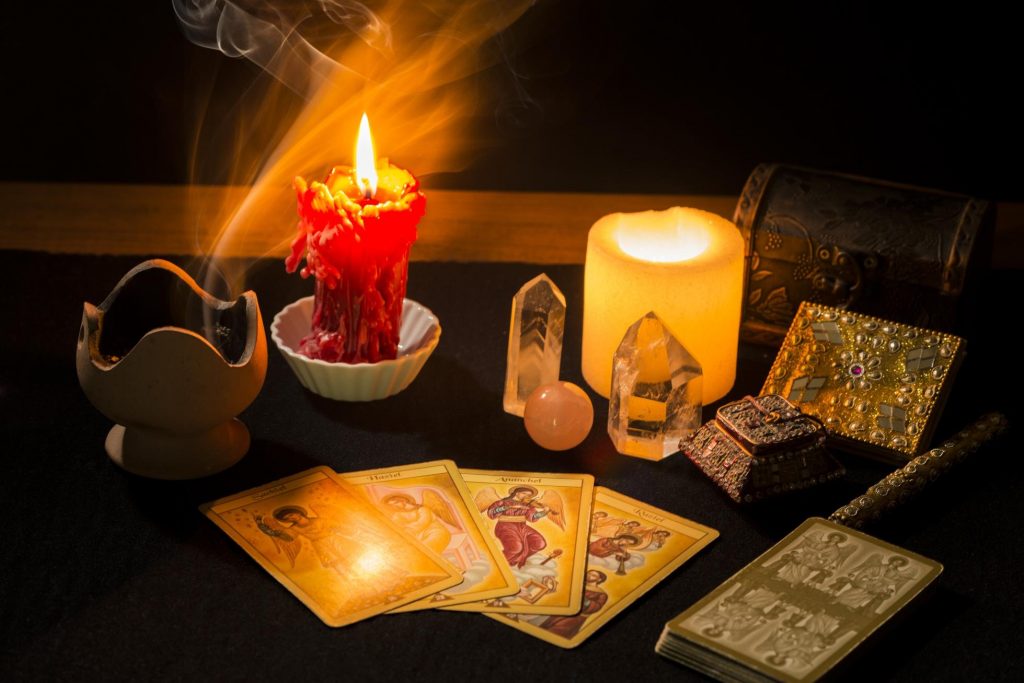In a chamber beneath the Petit Ermitage Hotel in West Hollywood, 11 seekers gather around a seance table. Deliberately left without a medium to channel the dead, they’re sequestered with their imaginations, what the event organizer calls “the liminal space between belief and disbelief in the paranormal.”
The séance, called Phasmagorica, has become a Los Angeles hot spot for occult enthusiasts, the merely curious, and perhaps a few who genuinely want to talk to a deceased aunt. The 80-minute evening is an inventive convergence of art installation, paranormal experiment and immersive happening—the latter experiencing explosive growth in recent years. With no actors, jump scares or hidden wires, every guest becomes the medium, left with their own belief or disbelief.
A Séance Without A Medium
“I’m not a medium or spiritual guide. I approach it as an artist, a creative explorer,” says Phasmagorica creator BC Smith, a composer who is also a member of the Academy of Magical Arts and a regular at its clubhouse in Hollywood, the Magic Castle.
The séance setup includes guided narration, atmospheric lighting and a 13-speaker Dolby sound system that delivers a sonic underscore. Curated trigger objects—personal keepsakes, vintage photographs, even a wooden arm—sit in labeled drawers that guests are invited to open.
By removing the medium, Smith turns guests and their imaginations into active participants, each becoming a conduit for unseen worlds, or what suggestive minds create.
“Something wild and unexplainable keeps happening in that room, and hearing what people experience has been the best part,” says Smith, who launched the sell-out events in late summer at the Heritage Square Museum before moving to the Petite Ermitage in mid October. Priced at $110, Phasmagorica seats 11 guests Thursday through Sunday and runs through December.
Guests Hear Voices, See Shadows During The Séances
To chronicle the encounters, Smith compiles field notes, much like a researcher or anthropologist, compiling them in what he terms the “Archivist.” The notes include reports of an amorphous shadow figure; a guest who smelled cinnamon, followed by a child’s voice whispering “pretty, pretty;” and air currents flowing beneath the séance table.
Smith says synchronicities have occurred around trigger objects: a pocket watch mysteriously set to a guest’s birthday, a doll bearing an eerie resemblance to the person who selected it, and other items associated with personal significance. The room’s scrying mirrors—reflective surfaces traditionally used for divination—have produced similar results. Guests have seen faces that weren’t their own, along with aged and younger visions of themselves.
The Power Of Imagination And Suggestion
The curious phenomenon guests observe during the séance begs the question: can confirmation bias and the power of suggestion induce people to perceive paranormal events? In a 2003 study in the British Journal of Psychology, one-third of participants in staged séances falsely reported a levitating table. “Approximately one-fifth of participants believed that the fake séances contained genuine paranormal phenomena,” states the report.
Looking at the event from a scientific angle, Dr. Simon Faynboym, a psychiatrist and medical doctor at the Los Angeles-based Neuro Wellness Spa, says séance cues like lighting and sound can “play with how our senses and brains work—our brain naturally tries to fill in the gaps, and therefore makes us see patterns, like faces in shadows or whispers in noise.”
He notes that the setting is crucial, “because when everyone is told to expect strange events, adrenaline rises, attention narrows, subtle sounds are noticed and ordinary sensations feel bigger, which is more meaningful and personal.”
For his part, Smith says, “I’ve seen too many inexplicable things happen and too many crazy things reported by guests—it’s made me a believer. I’m not out to prove—simply to provoke and inspire a conversation.”
The Occult’s Rising Appeal
Interest in the occult has risen in the past decade, especially among young people. A 2025 Pew Research Center study found that nearly one-third of American adults consult occult practices, including fortune tellers, tarot cards and astrology at least once a year.
“There’s something so compelling about the idea that there are charismatic individuals out there with specialized abilities or knowledge,” says magic and occult historian Katherine Walker, an associate professor of English at the University of Nevada. “In times when scientific certainty or even political stability is threatened, the lure of other possibilities tends to flourish.” She cites the popularity of fortune tellers and healers on the heels of the Reformation and the violent Wars of Religion in 16th and 17th-century Europe.
Lisa Morton, author of the 2022 book, Calling the Spirits. A History of Séances details the history of séances through various sources. Among them: the Fox sisters, who ran séances in the late 1800s as part of the spiritualism movement that lured people across social classes. The HBO series The Gilded Age highlighted how popular the practice became during Victorian times. A vulnerable Ada Brook Forte (Cynthia Nixon) attends several séances while mourning her dead husband.
Whether one is a skeptic or a believer in séances, the event’s achievement makes room for both views. Certainty is not on the menu—perhaps the most defining element of the experience. “As its creator,” Smith says, “I find it all beautifully unresolved.”

